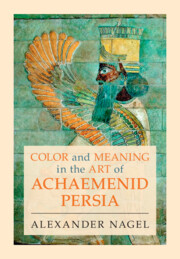Book contents
- Color and Meaning in the Art of Achaemenid Persia
- Color and Meaning in the Art of Achaemenid Persia
- Copyright page
- Contents
- Figures
- Acknowledgments
- Introduction: The Most Beautiful Blues
- Chapter One Defining Polychromies
- Chapter Two Historiographical Overview, Part I: Approaching Achaemenid Persian Polychromies in the Nineteenth Century – Ancient Literary Testimony and Modern Discourses
- Chapter Three Historiographical Overview, Part II: Approaching Achaemenid Persian Polychromies in the Twentieth Century
- Chapter Four Uncomfortable Truths: Challenges of Documenting and Preserving Achaemenid Persian Polychromies
- Chapter Five A Discussion: Aspects of Nonverbal Communication in the Achaemenid Persian Empire
- Chapter Six Concluding Contemplations
- Bibliography
- Index
Chapter Four - Uncomfortable Truths: Challenges of Documenting and Preserving Achaemenid Persian Polychromies
Published online by Cambridge University Press: 24 August 2023
- Color and Meaning in the Art of Achaemenid Persia
- Color and Meaning in the Art of Achaemenid Persia
- Copyright page
- Contents
- Figures
- Acknowledgments
- Introduction: The Most Beautiful Blues
- Chapter One Defining Polychromies
- Chapter Two Historiographical Overview, Part I: Approaching Achaemenid Persian Polychromies in the Nineteenth Century – Ancient Literary Testimony and Modern Discourses
- Chapter Three Historiographical Overview, Part II: Approaching Achaemenid Persian Polychromies in the Twentieth Century
- Chapter Four Uncomfortable Truths: Challenges of Documenting and Preserving Achaemenid Persian Polychromies
- Chapter Five A Discussion: Aspects of Nonverbal Communication in the Achaemenid Persian Empire
- Chapter Six Concluding Contemplations
- Bibliography
- Index
Summary
Documentation of evidence for polychromy on the limestone façades and monuments of Persepolis, Naqsh-e Rustam, and Susa extends back over two centuries. This effort has been intensified in the last several decades, as we have seen in previous chapters. In all that time many approaches to the recording, preserving, and analyzing of traces of paint have come and gone. Today there are advanced nondestructive techniques for discerning elusive traces of pigment. The most effective of these are more viable in a museum conservation laboratory on isolated monuments or fragments than they can possibly be at vast open-air sites. Thus, for instance, it was possible to use a portable XR-fluorescence spectrometer (XRF) when examining a number of Achaemenid Persian relief sculptures housed in the Vorderasiatisches Museum Berlin.1 I was able to employ a digital microscope (Keyence) on outdoor monuments in Persepolis and when studying collections in the museums of Persepolis, Tehran, and Washington, DC, together with stone conservation specialists.2
- Type
- Chapter
- Information
- Color and Meaning in the Art of Achaemenid Persia , pp. 140 - 171Publisher: Cambridge University PressPrint publication year: 2023

